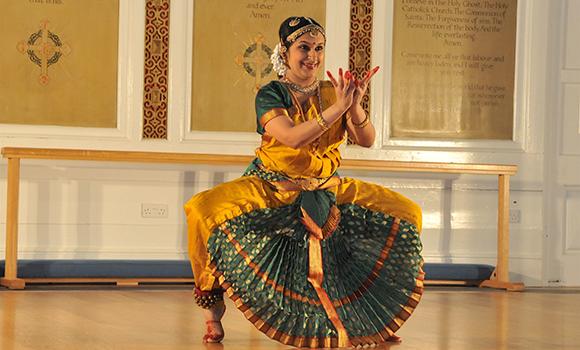
Krishna Zivraj-Nair loved her work as a research scientist in a Cambridge lab — but there was something missing. Dance has always been one of her passions and, from small beginnings, she’s established a flourishing dance academy.
Classical dance, Indian or Western, is a perfect way to train mind and body
Krishna Zivraj-Nair
I’ve always been one of those people who can’t keep still. I’m interested in so many things and need to be busy all the time. I run a dance school but until 2010 I also had a career in scientific research. In fact, I still keep up with the science by working in scientific communication as the director of ASK Scientific Ltd.
As a child growing up in India I was fascinated by biology and how our bodies work. I grew up with my grandparents in Bangalore. Spotting my interest in movement, my grandparents and aunt enrolled me in Bharatanatyam dance classes. Bharatanatyam is a classical Indian dance form traditionally performed in temples but now staged more widely. We even did a flash mob performance in Cambridge’s Market Square.
My first Bharatanatyam dance teacher remains my role model. I think about Padma Murali, director of the Padmalaya Dance Foundation, every single day. She encouraged her students to do their best and never intimidated them. Whenever I’m teaching my pupils a new movement, I think: “Now, how would Padma aunty explain this?”
I went to the US to take my first degree. At Albright College in Pennsylvania, I majored in biochemistry and French. It’s a liberal arts college and the courses open to us were wonderfully diverse. I was able to take art history and literature alongside my major subjects. It suited me perfectly but I admit I was left confused about what direction to follow.
Returning to Bangalore, I spent six months as an internship student at the National Centre for Biological Sciences (NCBS). This stint was a wonderful introduction to the world of research: I realised that I loved working in a lab and carrying out experiments. The lab’s principal investigator, Apurva Sarin, let me explore the world of research while I was mentored by one of her PhD students.
I went on to take a master’s in Geneva and PhD in Hamburg. I worked in a lab looking at neural circuitry in the olfactory system of mice. My PhD focused on understanding how messenger RNAs and proteins get transported within neurons in the brain. In 2006, I started my postdoctoral research in Christine Holt’s lab in Cambridge. Her lab looks at how nerve connections are established and maintained during development.
My husband, Amit Nair, did his PhD at Cambridge’s Department of Zoology and his postdoctoral research at the Babraham Institute. We first met when I was an intern at NCBS, Bangalore, and we were incredibly fortunate to find postdoc positions in Cambridge. For both of us, Cambridge has turned out to be a city of opportunities.
During my years in scientific research, I never lost my passion for dance. I organised multi-cultural student dances at the institutions where I was working and, however small my room was, I’d practise almost every day. Even though I loved doing science, I felt there was something missing.
People started asking me to teach their children Bharatanatyam. Dance is an integral part of Indian culture and many parents want their children to experience it. I started in a small way, teaching for a couple of hours after work. From 2011, there was a boom in all kinds of dance. I met Anusha Subramanyam and Anita Srivastava, two well-known dance artists, and they became my mentors.
I set up the Sanskruti School of Dance in 2007. Our classes take place at Parkside Community College in central Cambridge and, in a smaller way, in Sawston where I live. We teach three types of dance to children and adults: Indian classical dance forms Bharatanatyam and Odissi, and the more popular Bollywood dance style. In addition, we have classes in classical Indian music — Carnatic Vocals and Veena, the south Indian string instrument.
Cambridge City Council has been wonderfully supportive in helping us to introduce young people to Indian art forms. Each year we perform at the Big Weekend Festival, a community arts celebration on Parker’s Piece, and the Council has funded us to run workshops in local schools.
I’ve begun to devise new pieces. I believe that classical dance, Indian or Western, is a perfect way to train mind and body. Bharatanatyam and Odissi are essentially story-telling traditions. Both can be made accessible to young children who are not necessarily from an Indian cultural background. Performing allows children to imagine, communicate and gain confidence.
‘Apple and Spice’ is a piece for young audiences. I developed it with a team of artists and mentors. An Indo-European fairy tale, it tells the stories of two step-mothers, one from the East and one from the West. The performance combines classical dance, music, shadow puppetry and narration with plenty of audience interaction. We devised it with funding from the Arts Council and the South Asian dance organisation, Akademi, plus generous support from the arts venue, Cambridge Junction.
Dance brings people together — it has a cohesive effect. I observe this magic each week in my classes, which unite students of different backgrounds and ages. Most, but not all, of my pupils have Indian or South Asian heritage. Some of them started with me as children a decade ago. Dance puts them in touch with their own cultures.
This profile is part of our This Cambridge Life series.
